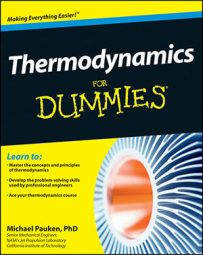Sooner or later, you’re going to have to convert from one unit of physical measurement to another. This list gives you some of the most common conversion factors you need in thermodynamics.
Acceleration: 1 m/s2 = 100 cm/s2
Area: 1 m2 = 104 cm2 = 106 mm2
Density: 1 g/cm3 = 1 kg/L = 1,000 kg/m3
Energy, heat, work, internal energy, enthalpy: 1 kJ = 1,000 J = 1,000 N·m = 1 kPa·m3
1 kJ/kg = 1,000 m2/s2
Force: 1 N = 1 kg·m/s2
Length: 1 m = 100 cm = 1,000 mm
Mass: 1 kg = 1,000 g
Power, heat transfer rate: 1 W = 1 J/s, 1 kW = 1,000 W
Pressure: 1 Pa = 1 N/m2, 1 kPa = 1,000 kPa, 1 MPa = 1,000 kPa
1 atmosphere (atm) = 101.325 kPa
Specific heat, entropy: 1 kJ/kg · °C = 1 kJ/kg · K = 1 J/g·°C
Specific volume: 1 m3/kg = 1,000 L/kg = 1,000 cm3/kg
Temperature: T(K) = T(°C) + 273.15, T(°C) = (5/9) T(°F) – 32, T(°F) = (9/5) T(°C) + 32
Velocity: 1m/s = 3.6 km/hr
Volume: 1 m3 = 1,000 L = 106 cm3

